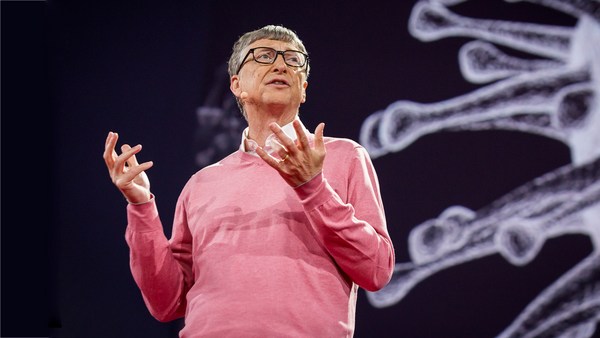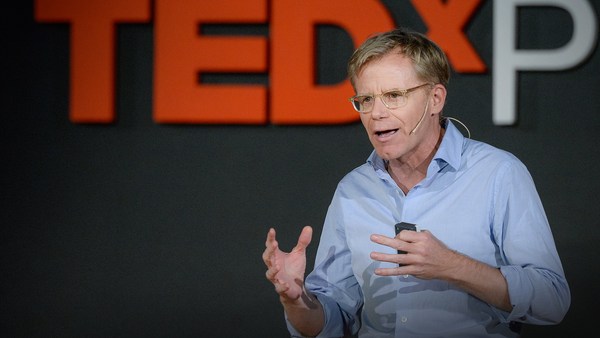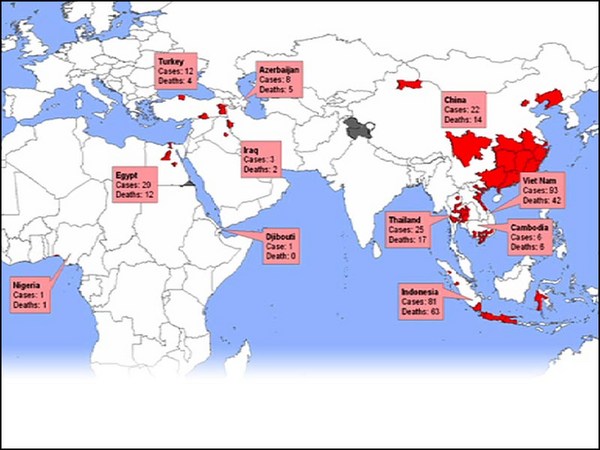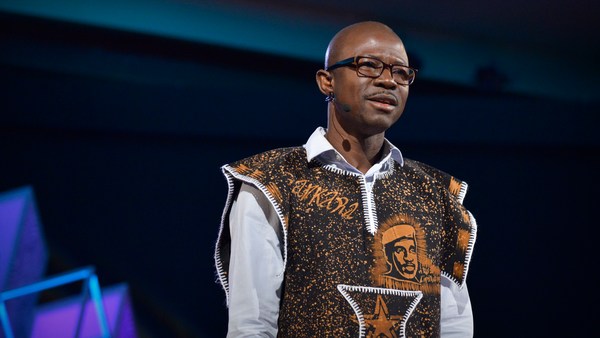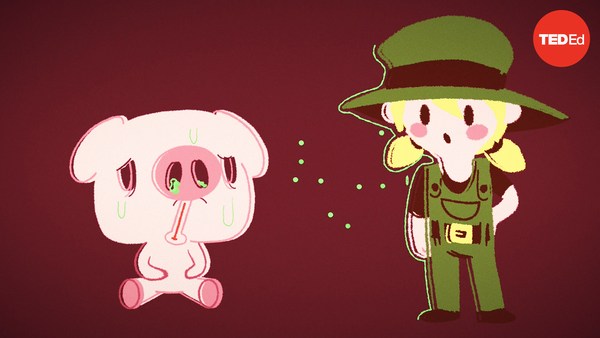You may never have heard of Kenema, Sierra Leone or Arua, Nigeria. But I know them as two of the most extraordinary places on earth.
In hospitals there, there's a community of nurses, physicians and scientists that have been quietly battling one of the deadliest threats to humanity for years: Lassa virus. Lassa virus is a lot like Ebola. It can cause a severe fever and can often be fatal. But these individuals, they risk their lives every day to protect the individuals in their communities, and by doing so, protect us all.
But one of the most extraordinary things I learned about them on one of my first visits out there many years ago was that they start each morning -- these challenging, extraordinary days on the front lines -- by singing. They gather together, and they show their joy. They show their spirit. And over the years, from year after year as I've visited them and they've visited me, I get to gather with them and I sing and we write and we love it, because it reminds us that we're not just there to pursue science together; we're bonded through a shared humanity.
And that of course, as you can imagine, becomes extremely important, even essential, as things begin to change. And that changed a great deal in March of 2014, when the Ebola outbreak was declared in Guinea. This is the first outbreak in West Africa, near the border of Sierra Leone and Liberia. And it was frightening, frightening for us all. We had actually suspected for some time that Lassa and Ebola were more widespread than thought, and we thought it could one day come to Kenema.
And so members of my team immediately went out and joined Dr. Humarr Khan and his team there, and we set up diagnostics to be able to have sensitive molecular tests to pick up Ebola if it came across the border and into Sierra Leone. We'd already set up this kind of capacity for Lassa virus, we knew how to do it, the team is outstanding. We just had to give them the tools and place to survey for Ebola.
And unfortunately, that day came. On May 23, 2014, a woman checked into the maternity ward at the hospital, and the team ran those important molecular tests and they identified the first confirmed case of Ebola in Sierra Leone. This was an exceptional work that was done. They were able to diagnose the case immediately, to safely treat the patient and to begin to do contact tracing to follow what was going on. It could've stopped something. But by the time that day came, the outbreak had already been breeding for months. With hundreds of cases, it had already eclipsed all previous outbreaks. And it came into Sierra Leone not as that singular case, but as a tidal wave.
We had to work with the international community, with the Ministry of Health, with Kenema, to begin to deal with the cases, as the next week brought 31, then 92, then 147 cases -- all coming to Kenema, one of the only places in Sierra Leone that could deal with this.
And we worked around the clock trying to do everything we could, trying to help the individuals, trying to get attention, but we also did one other simple thing. From that specimen that we take from a patient's blood to detect Ebola, we can discard it, obviously. The other thing we can do is, actually, put in a chemical and deactivate it, so just place it into a box and ship it across the ocean, and that's what we did. We sent it to Boston, where my team works. And we also worked around the clock doing shift work, day after day, and we quickly generated 99 genomes of the Ebola virus. This is the blueprint -- the genome of a virus is the blueprint. We all have one. It says everything that makes up us, and it tells us so much information.
The results of this kind of work are simple and they're powerful. We could actually take these 99 different viruses, look at them and compare them, and we could see, actually, compared to three genomes that had been previously published from Guinea, we could show that the outbreak emerged in Guinea months before, once into the human population, and from there had been transmitting from human to human. Now, that's incredibly important when you're trying to figure out how to intervene, but the important thing is contact tracing. We also could see that as the virus was moving between humans, it was mutating. And each of those mutations are so important, because the diagnostics, the vaccines, the therapies that we're using, are all based on that genome sequence, fundamentally -- that's what drives it. And so global health experts would need to respond, would have to develop, to recalibrate everything that they were doing.
But the way that science works, the position I was in at that point is, I had the data, and I could have worked in a silo for many, many months, analyzed the data carefully, slowly, submitted the paper for publication, gone through a few back-and-forths, and then finally when the paper came out, might release that data. That's the way the status quo works.
Well, that was not going to work at this point, right? We had friends on the front lines and to us it was just obvious that what we needed is help, lots of help. So the first thing we did is, as soon as the sequences came off the machines, we published it to the web. We just released it to the whole world and said, "Help us." And help came.
Before we knew it, we were being contacted from people all over, surprised to see the data out there and released. Some of the greatest viral trackers in the world were suddenly part of our community. We were working together in this virtual way, sharing, regular calls, communications, trying to follow the virus minute by minute, to see ways that we could stop it.
And there are so many ways that we can form communities like that. Everybody, particularly when the outbreak started to expand globally, was reaching out to learn, to participate, to engage. Everybody wants to play a part. The amount of human capacity out there is just amazing, and the Internet connects us all. And could you imagine that instead of being frightened of each other, that we all just said, "Let's do this. Let's work together, and let's make this happen."
But the problem is that the data that all of us are using, Googling on the web, is just too limited to do what we need to do. And so many opportunities get missed when that happens. So in the early part of the epidemic from Kenema, we'd had 106 clinical records from patients, and we once again made that publicly available to the world. And in our own lab, we could show that you could take those 106 records, we could train computers to predict the prognosis for Ebola patients to near 100 percent accuracy. And we made an app that could release that, to make that available to health-care workers in the field.
But 106 is just not enough to make it powerful, to validate it. So we were waiting for more data to release that. and the data has still not come. We are still waiting, tweaking away, in silos rather than working together. And this just -- we can't accept that. Right? You, all of you, cannot accept that. It's our lives on the line. And in fact, actually, many lives were lost, many health-care workers, including beloved colleagues of mine, five colleagues: Mbalu Fonnie, Alex Moigboi, Dr. Humarr Khan, Alice Kovoma and Mohamed Fullah. These are just five of many health-care workers at Kenema and beyond that died while the world waited and while we all worked, quietly and separately.
See, Ebola, like all threats to humanity, it's fueled by mistrust and distraction and division. When we build barriers amongst ourselves and we fight amongst ourselves, the virus thrives. But unlike all threats to humanity, Ebola is one where we're actually all the same. We're all in this fight together. Ebola on one person's doorstep could soon be on ours. And so in this place with the same vulnerabilities, the same strengths, the same fears, the same hopes, I hope that we work together with joy.
A graduate student of mine was reading a book about Sierra Leone, and she discovered that the word "Kenema," the hospital that we work at and the city where we work in Sierra Leone, is named after the Mende word for "clear like a river, translucent and open to the public gaze." That was really profound for us, because without knowing it, we'd always felt that in order to honor the individuals in Kenema where we worked, we had to work openly, we had to share and we had to work together. And we have to do that. We all have to demand that of ourselves and others -- to be open to each other when an outbreak happens, to fight in this fight together. Because this is not the first outbreak of Ebola, it will not be the last, and there are many other microbes out there that are lying in wait, like Lassa virus and others. And the next time this happens, it could happen in a city of millions, it could start there. It could be something that's transmitted through the air. It could even be disseminated intentionally. And I know that that is frightening, I understand that, but I know also, and this experience shows us, that we have the technology and we have the capacity to win this thing, to win this and have the upper hand over viruses. But we can only do it if we do it together and we do it with joy.
So for Dr. Khan and for all of those who sacrificed their lives on the front lines in this fight with us always, let us be in this fight with them always. And let us not let the world be defined by the destruction wrought by one virus, but illuminated by billions of hearts and minds working in unity.
Thank you.
(Applause)
